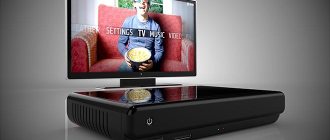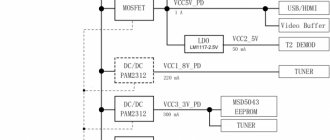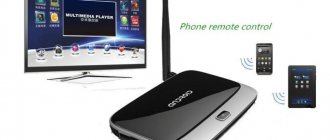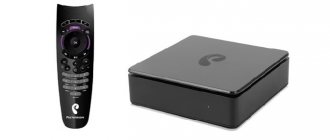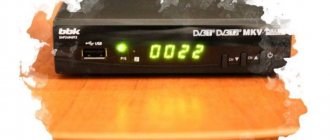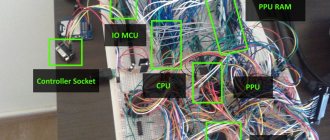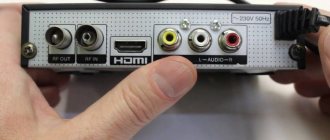The new IPTV technology is based on the transmission of digital television signals via computer IP networks. For this purpose, the signal is encrypted and transmitted to a playback device, which can be a home computer or special equipment - an IPTV set-top box or STB (IP Set-Top-Box). The image is broadcast and the signal is decrypted on a computer using IPTV players. For this purpose, the STB set-top box uses electronic decoder circuits that convert the digital signal into analog video for the TV.
Advantages of IPTV technology
The main advantage of this technology is open access to digital resources such as IP telephony and IP television.
Reliability of data transmission is guaranteed by the similar operating principle of both technologies and the use of fiber optic cable for transmitting a television or telephone signal. Excellent broadcast quality allows you to view programs in high definition with multi-channel sound and excellent color reproduction.
Interactivity is another advantage of the technology: the IP connection works in both directions - from the server to the client and back. Thanks to this, the consumer can control the service from an STB set-top box or computer.
"NTV-Plus VA1020"
This new generation receiver joined the NTV-Plus equipment line at the end of 2021. The appearance of the model does not hint at anything unusual. The design shows the family features of “NTV-Plus 1 HD VA”: the same rounded body, seven-segment display. True, the conditional access card is inserted from the side, but this does not spoil the appearance, since it is completely hidden in the receiver body, which has large recesses for its removal. There are also markings to show you how to properly insert the smart card into the slot.
The back panel is very rich in terms of interfaces. The only thing missing is a satellite output. The manufacturer took care of high-quality warranty service, prohibiting opening the set-top box. For this purpose, a protective mark is glued to the body. The receiver indicates that it is turned on with a green LED, and the display shows the channel number or clock. First of all, the set-top box tries to find a satellite signal and offers to install the latest update. If the signal is not received, you need to check for passive equipment that may cause interference.
The menu is reminiscent of the tiled interface of Windows 10. All navigation is designed to be controlled by five buttons. Users accustomed to NTV-Plus receivers will have to get used to both the new menu and the format for providing information on the screen.
The VA1020 is a hybrid set-top box, that is, it simultaneously connects to the satellite and the Internet (via an Ethernet cable or via Wi-Fi). This allows, in addition to linear television viewing, the use of OTT services. In the online cinema, subscribers can choose and immediately watch the movie they like. To do this, you need to have a paid NTV-Plus subscription and activate. Content is delivered over the Internet. Of course, all films are divided into categories. The operator’s partner is Ivi.ru LLC (ivi online cinema), so you can count on the quality and variety of content.
Many channels have access to a program archive. This is very convenient for people who work or are often busy, but still want to watch their favorite series or TV show. The depth (storage time) of the archive is different for different programs. For example, we were able to find programs with an archive depth of 7 days.
The functions Timeshift, pause, rewind, delayed viewing are also included in the interactive ones; they work without connecting a hard drive and, more importantly, without formatting it.
Of course, the receiver contains interesting ideas. A product of this class is new for the operator, and therefore there are some shortcomings. However, regularly released updates make it clear that NTV-Plus is seriously concerned about the development of the receiver.
What could the developer borrow from more advanced analogues? First of all, the use of two operating systems. Let one of them - Linux - be responsible for satellite reception, and the second - Android - be used to launch user applications, including an online cinema. Technologies for delimiting access to memory have been tested for a long time, so all that remains is to apply them correctly. Even if NTV-Plus leaves only its own application store, it can be easily filled with ported programs.
Another aspect of the functioning of the set-top box is easy to solve right now. To work with Internet broadcasts, the receiver needs to log in to the OTT service provider’s server using the subscriber’s data. at the same time, for some reason, the possibility of connecting a second similar set-top box (say, in another room) under the same contract remained unrealized. Such a simple solution would make it possible to organize a multiroom service on existing equipment. I would also really like the receiver to be able to receive content from a mobile device. This can be implemented through a separate application for Android/iOS. Well, if the set-top box is called interactive, then let it notify the user when an event of interest to him will be broadcast. Let's say a user wants to watch the movie "Guardians of the Galaxy 2", and it would be nice for the set-top box to tell him when it will be on the channels included in the subscription.
Functionality of set-top boxes
The RT STB HD IPTV set-top box connected to TV has the following functions:
- Receive video materials upon request. The server hosts a library of VoD video materials, accessing which allows you to access a particular film. Often video materials are provided for a fee.
- Control your viewing using Time Shifted TV technology. Software for a computer or STB HD set-top box for a TV allows you to rewind a TV program in any direction and temporarily pause its broadcast.
- An alternative version of the VoD service – the nVoD service – allows you to create a personal TV program. A public cinema allows a group of users to coordinate their viewings among themselves.
- The TVoD service allows you to postpone watching a movie or video. The user just needs to select the necessary TV shows and TV channels in advance and send a request for viewing in the future.
Thickness matters
Another indicator by which we compared receivers was the thickness of the case. The receiver, called a set-top box, is no longer placed directly on the TV. Where should the subscriber place it? If the user has a special TV stand, then it has a niche for TV set-top boxes. however, when the receiver is installed on the bedside table, the receiver should also take a place nearby. In this case, it is advisable to install it between the TV and the bedside table, and if the TV is mounted on a bracket, the receiver is hidden behind the TV. Therefore, modern devices connected to a TV are specially produced in a thin case to fit under the TV, or are connected to an external IR receiver. For some reason, NTV-Plus chose a different path, as a result, each subsequent generation of the receiver is thicker than the previous one. For example, the Sagemcom DSI74 HD can be placed under a TV without any problems with a standard distance from the stand to the bottom edge of the screen, but other models cannot be installed in the same way.
Set-top box capabilities
The main advantage of STB set-top boxes is a large number of interactive services and the ability to directly manage content. The set-top box provides access to most Internet services: Picasa, YouTube and others, plus such devices are equipped with USB ports that allow you to connect external devices. Through RT STB HD IPTV set-top boxes, it is possible to play video files from external media, view photos and images, and when connected to a Wi-Fi router, access network video resources. The video stream can be redirected to a computer or laptop.
"Iron" guarantors
Each satellite or cable television provider has a set of subscriber equipment recommended for use.
It is when using it that the operation of services is guaranteed and claims regarding the quality of the service provided are accepted. This is due, among other things, to the need to monitor signal parameters: if they change, the operator checks the functionality of the recommended equipment. If the modifications are fatal and lead to malfunctions of the receivers, then the signal has to be returned to its original state. And, of course, the operator develops its own range of services and must be sure that they are available to the subscriber. For example, sometimes you come across satellite receivers that cannot display the program guide (EPG), but only show information about the current and next events. Another argument in favor of using the recommended equipment is the requirements of copyright holders for content protection. Free handling of it reduces the profits of both the content owners and the operator himself.
Set-top box equipment
The contents of the device may vary depending on the specific model: some elements may be present, others may not.
The approximate configuration of the STB set-top box from Rostelecom includes:
- Universal USB ports, one of which is located on the front panel of the set-top box, the second on the back.
- An RC connector can be placed for an infrared remote receiver. Its presence is determined by the specific STB set-top box model.
- Ethernet connector with a maximum connection speed of 100 Mb/s. It allows you to connect the set-top box to the network of the provider providing Internet services.
- HDMI connector for connecting the set-top box to the TV.
- HDMI cable. It is extremely rarely included with an STB set-top box; most often the user has to purchase it themselves.
- A cable with three connectors connects to the analog AV connector. One of the connectors is intended for video broadcasting, the other two are for audio.
- Connector for AA batteries.
The listed connectors are located on the rear panel of the set-top box.
Scope of delivery and features
The editors were provided with the following models for testing: Sagemcom DSI74 HD, Opentech OHS1740V, NTV-Plus 1 HD VA and NTV-Plus VA1020. All models come with a remote control, batteries for it, an external power supply (12 V) and an HDMI cable. Small differences in configurations are caused by the manufacturer’s desire to please the subscriber. Thus, the Sagemcom DSI74 HD includes a mini-jack-3xRCA adapter. And the VA1020 model has an RCA-RCA cable in the box. In addition, this receiver has one more feature: the hole for connecting an external power supply is smaller in diameter than other receivers. Because of this, the power supplies of other NTV-Plus receivers are not suitable for it. If the power supply fails, this can cause additional problems.
Connecting the device
The set-top box is connected to older TV models via the AV connector using a cable with three connectors. Modern TV models equipped with an HDMI input are connected via an HDMI cable. Accordingly, in the latter version the quality of sound and image is much better.
The set-top box is connected to the network via a router. Some users connect the provider's cable directly to the network connector of the set-top box, but this move is not always advisable, since various additional devices are most often connected to the set-top box. Accordingly, the LAN connector is connected to a similar connector on the router. After the set-top box is connected correctly, the corresponding image is displayed on the TV screen.
Navigation in the device menu is carried out using the corresponding keys on the control panel of the set-top box.
How to find out if your TV supports ARC
Unfortunately, and for unknown reasons, manufacturers rarely label connectors with the ARC option on their devices. Some TVs may have ARC on HDMI 1, others may have ARC on HDMI 2. And the only way to find out whether your TV supports ARC is in the technical documentation or on the manufacturer's website.
In the past, no one read TV specification sheets because they were filled with obscure technical terms and acronyms, but now you have to look there to find out the TV's ARC implementation.
If your TV manual says that the HDMI controller version is v1.4, then you will definitely have support for Audio Return Channel. If your TV receiver model has an HDMI 1.3 controller, then the device does not support ARC.
Setting up the set-top box software
There is a SETUP key on the control panel, which is used to configure the set-top box. The device is configured as follows:
- In the “Advanced settings” menu item you can set the date, time and time zone. To fully use the interactive capabilities of the set-top box, this must be done, since the data is synchronized with the IPTV server.
- If the set-top box is connected through a router, then you need to configure it as a network device. This is done through the “Network Configuration” menu item: in the window that opens, select a specific network type - for example, a wired Ethernet connection.
- In the next window that opens, the DHCP mode is activated by pressing the key labeled “Auto (DHCP)”. In the window that appears, click OK.
- The readiness of the network for operation is checked in the “Network Status” menu. An Ethernet connection is selected and a request is sent. In response, a window should open with a list of TCP/IP settings: the user must make sure that all configurations are specified correctly.
- The next step is to configure the servers. In the menu of the same name, enter the following data in the NTP server field: pool.ntp.org. All data is entered through an electronic keyboard, which is controlled via keys on the remote control.
- In the “Video Settings” menu item, the playback of video materials is adjusted. It is advisable to disable options such as auto frame rate switching and DVI forcing. Next, the required monitor resolution is set by analogy with setting up a computer monitor. Lastly, the video output mode is assigned. You can configure this item according to the instructions for the set-top box. Older models equipped with an AV input use PAL mode.
In the “Reboot” menu, all configured settings are saved, after which the set-top box is rebooted. If the connection and subsequent configuration are correct, you will be able to use the set-top box immediately after restarting it.
Remote controls
From left to right: Sagemcom, Opentech, NTV-PLUS 1 HD VA, VA1020
We give the palm of beauty to the Sagemcom remote control, which looks more impressive than its competitors. The control buttons on it are located in places where it is easy to reach with your thumb, and the markings on them are easy to read. The only drawback is the heavy movement of the buttons. Each key must be pressed until it is activated.
The buttons on the Opentech remote control are more pleasant to press, but their small size and excessive number of them do not allow you to use the remote control intuitively. During testing, I constantly had to look at the remote control to find the right button. But the abundance of keys allows you to call almost all functions of the receiver from the remote control without resorting to the menu.
The remote control for the NTV-plus 1 HD VA model, developed by Jiuzhou, turned out to be quite good. It is clear that work has been done on ergonomics. It fits well in the hand, the button travel is pleasant and soft. This is perhaps the best of the remotes, design aside.
But when creating the remote control for the NTV-Plus VA1020 receiver (manufactured by Kaonmedia), the developer went a little overboard by reducing the size and number of buttons. The remote control itself turned out to be quite good, but the vendor emphasized using the receiver menu. It doesn't even have a program guide button.
In general, all remote controls cope with their purpose.

